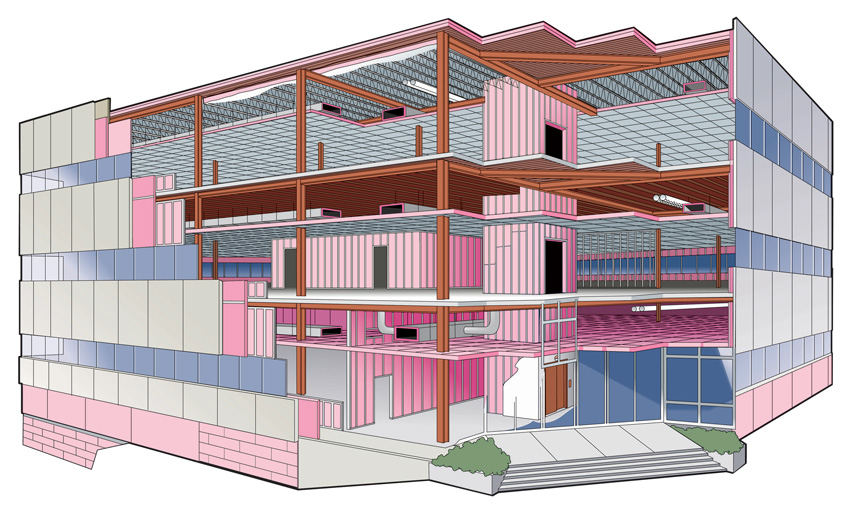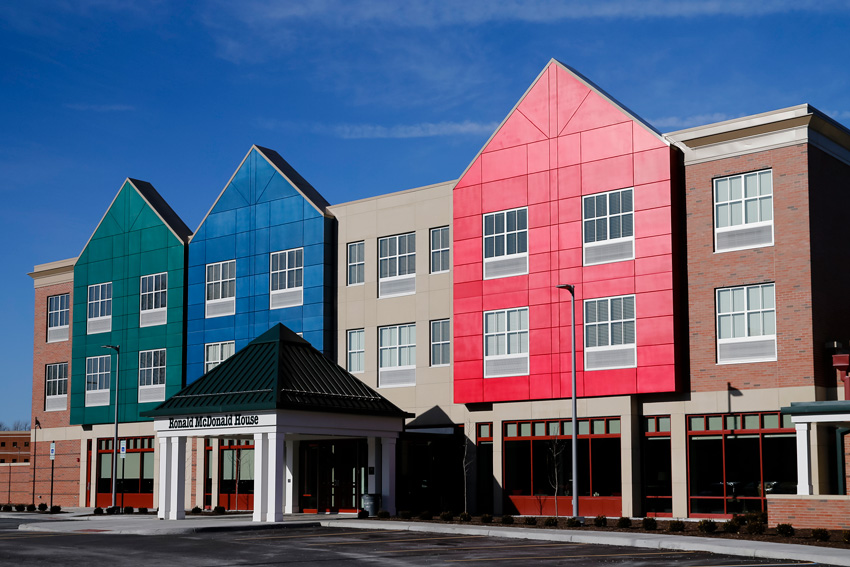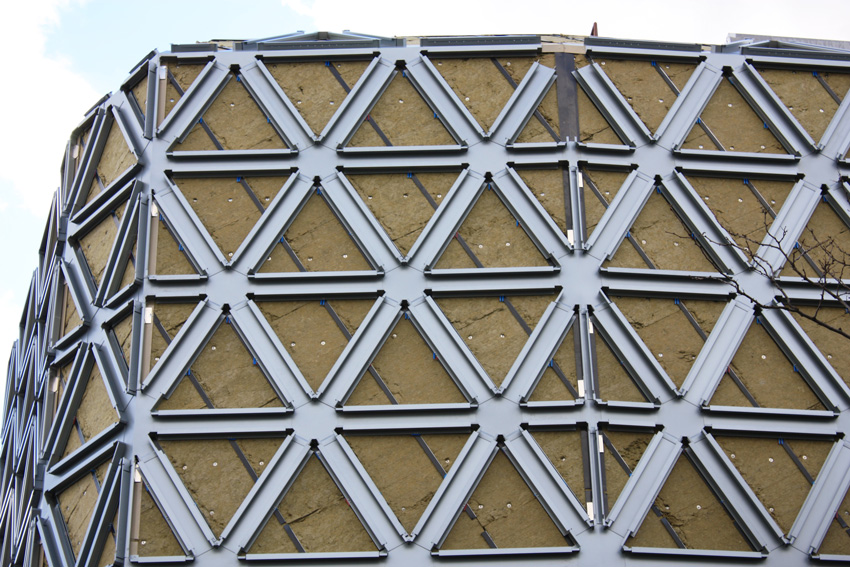Understanding Sustainable Insulation and LEED v4
Materials and Resources
The Materials and Resources credit category has arguably changed the most out of all of the existing credit categories. The only prerequisites and credits that look remotely similar to the LEED 2009 version are Storage and Collection of Recyclables and Construction and Demolition Waste Management Planning. The new credits include Building Life-Cycle Impact Reduction and Building Product Disclosure and Optimization for Environmental Product Declarations (EPD), Sourcing of Raw Materials, and Material Ingredients.
The Building Life-Cycle Impact Reduction has four options: historic building reuse, renovation of abandoned or blighted buildings, building and material reuse, or a whole-building life-cycle assessment. The intention of the credit is to encourage reuse of the energy already embodied in creating the existing building and lessen the building’s environmental impact.
The Building Product Disclosure and Optimization credits aim to encourage the use of products with limited impacts throughout their lifetimes and from manufacturers that provide transparency about their products’ ingredients and manufacturing processes. Chemical transparency and disclosure is understanding materials in products and understanding the hazards associated with those materials (pure chemical hazards, not risk as an end product). These credits are intended to allow for greater understanding in decision making.
In LEED 2009, these credits really focused on individual features like FSC-certified wood or a certain percentage of recycled material, but the new credits attempt to capture a more comprehensive view of the material’s sustainability throughout its life cycle. They not only encourage the project teams to use more sustainable materials but also incentivize product manufacturers to provide better, detailed information about where their products came from, how they were produced, and what they contain. Essentially, the new Materials and Resources category seeks to first disclose, then optimize, therefore transforming the market by driving product improvement.
The Product Life Cycle
LEED v4 includes product and whole building life-cycle assessment. A life-cycle assessment (LCA) is a compilation and evaluation of the inputs, outputs, and potential environmental impacts of a product system throughout its life cycle. In other words, a product’s cradle-to-grave environmental life cycle. ISO standards define “product” to be inclusive of a product or a service. The life-cycle assessment process not only can be applied to both items, but it also provides very good results for each. The term “life cycle” refers to the notion that a fair, holistic assessment of environmental impact requires the assessment of:
- Raw material production,
- Product manufacturing,
- Distribution,
- “Use” phase,
- Disposal phase, and
- Impact of all transportation steps.
Building Life-Cycle Impact Reduction Credit: Whole Building LCA Option
Under the Building Life-Cycle Impact Reduction Credit, there is also a Whole Building LCA option available for new construction only (this is one of four options). For new construction (buildings or portions of buildings), project teams should conduct a life-cycle assessment of the project’s structure and enclosure that demonstrates a minimum 10 percent reduction, compared with a baseline building, in at least three of the six impact categories listed below, one of which must be global warming potential. No impact category assessed as part of the life-cycle assessment may increase by more than 5 percent compared with the baseline building. These are the impact categories:
- Global warming potential (required)
- Stratospheric ozone
- Acidification
- Eutrophication
- Smog potential
- Nonrenewable energy

Product Disclosures: Environmental Product Declarations
The Materials and Resources category also has a Product Disclosures credit, which can include environmental product declarations (EPDs), sourcing of raw materials and material ingredients. There are both industry- and product-specific EPDs.
A project seeking credits under Option 1: Environmental Product Declaration must use at least 20 different permanently installed products sourced from at least five different manufacturers that have either a product-specific declaration (LCA) (¼ of a product), a generic industry-wide EPD (½ of a product), or a product-specific EPD (one full product). To qualify for an industry-wide EPD, the manufacturer must be explicitly recognized as a participant by the program operator.
Under Option 2: Multi-Attribute Optimization, a product must comply with at least one of the following criteria for 50 percent, by cost, of the total value of permanently installed products in the project. Third-party-certified products that demonstrate impact reduction below industry average in at least three of six categories:
- Global warming potential
- Depletion of ozone layer
- Acidification of water/land
- Eutrophication—pollution of water resources
- Formation of tropospheric ozone
- Depletion of nonrenewable resources
Value is determined as follows:
- 100 percent of cost for above criteria, and
- 200 percent of cost if product sourced within 100 miles of project site.
Life-cycle assessment data can be very technical with a lot of calculations and assumptions. An EPD is typically around 20 pages in length and is essentially a summary of all the data that is included in an LCA. However, an EPD presents the information in a format that is relatively easy to read and understand. In some ways, an EPD is similar to a nutrition label on a cereal box. However, in the case of an EPD, it covers the product’s environmental impact. The contents of an EPD include:
- Product definition and information about building physics
- Information about basic materials list
- Description of the product’s manufacture
- Indication of product processing and energy consumption
- Information about the in-use conditions
- Life-cycle assessment results
- Testing results and verifications
An EPD transparency brief is an even more concise, two-page summary showing life-cycle impact categories for a product and is a quick EPD reference tool. This document shows environmental impact categories in addition to standards upon which the declaration is based, as well as energy sources and usage, use of recycled content or materials, and other certifications held by the product. A transparency brief is a quick way to assess the environmental preferability of a product, quickly conveying important evaluation data for the purchaser, without having to dig through all the other text and less meaningful data.
Material Ingredients
In LEED v3, the Material Ingredients credit did not exist. In LEED v4, there are three options, but only two points are possible.

Option 1: Material Ingredients Reporting (one point)
The project must use at least 20 different permanently installed products from at least five different manufacturers that use programs to demonstrate the chemical inventory of the product to at least 0.1 percent (1,000 ppm). These programs include:
- Manufacturer inventory
- Health product declaration
- Cradle-to-Cradle certified at the v2 Basic or v3 Bronze level
- Declare: The Declare product label must indicate that all ingredients have been evaluated and disclosed down to 1,000 ppm.
- ANSI/BIFMA e3 Furniture Sustainability Standard: The documentation from the assessor or scorecard from BIFMA must demonstrate the product earned at least three points under 7.5.1.3 Advanced Level in e3-2014 or three points under 7.4.1.3 Advanced Level in e3-2012.
- Cradle-to-Cradle Material Health Certificate at the Bronze level or higher, and at least 90 percent of materials are assessed by weight
- ProductLens certification
- Facts: NSF/ANSI 336: Sustainability Assessment for Commercial Furnishings Fabric at any certification level
- Other USGBC-approved programs meeting the material ingredient reporting criteria
And/or Option 2: Material Ingredient Optimization (one point)
A project must use products that document their material ingredient optimization using GreenScreen, Cradle to Cradle, or REACH criteria for at least 25 percent, by cost, of the total value of permanently installed products in the project.
And/or Option 3: Product Manufacturer Supply Chain Optimization (one point)
A project must use building products for at least 25 percent, by cost, of the total value of permanently installed products in the project that source from a manufacturer with a robust safety, health, hazard, and risk programs, as well as a certified supply chain.
Some manufacturers of fiberglass, mineral wool and XPS foam insulation have Health Product Declarations, Declare labels, or Material Health Certificates from the Cradle-to-Cradle Innovations Institute that identify human health impacts and meet LEED MR Ingredients Disclosure requirements. Levels are Certified, Bronze, Silver, Gold, and Platinum.
The International Living Future Institute recognizes products and buildings designed for sustainability and well-being through their Living Product Label. Some fiberglass insulation such as unfaced batts and unbonded loosefill meet the International Living Future Institute’s Living Product Certification as well as Declare, which can help to meet LEED MR: Ingredients Disclosure requirements
Sourcing of Raw Materials
The intent of the Sourcing of Raw Materials credit is to encourage the use of products and materials for which life-cycle information is available and that have environmentally, economically, and socially preferable life-cycle impacts, as well as to reward project teams for selecting products verified to have been extracted or sourced in a responsible manner.
Option 1: Raw Material Source and Extraction Reporting (one point)
A project must use at least 20 different permanently installed products from at least five different manufacturers that have publicly released a report from their raw material suppliers that include extraction locations, and commitment to long-term ecologically responsible land use, reducing environmental harms from extraction and/or manufacturing, and address responsible sourcing criteria.
And/or Option 2: Leadership Extraction Practices (one point)
A project must use products that meet at least one of the responsible extraction criteria below for at least 25 percent, by cost, of the total value of permanently installed building products in the project:
- Biobased materials
- Recycled content
- Wood products certified by the FSC
- Extended producer responsibility
- Materials reuse
- USGBC approved program
For credit achievement calculation, products sourced (extracted, manufactured, and purchased) within 100 miles (160 kilometers) of the project site are valued at 200 percent of their base contributing cost.
Note that third-party certification identifies whether a product’s recycled content is post-consumer, pre-consumer, or post-industrial. Some common insulation materials with high recycled content are fiberglass insulation, mineral wool insulation, and XPS foam insulation.










